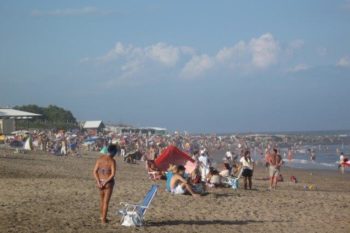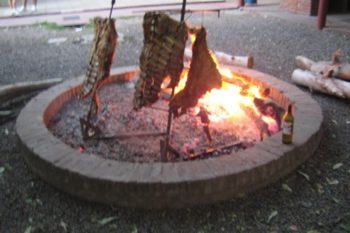It can be said that mate (pronounceed MAH-tay) is the national drink of Argentina, although the passion for this slightly bitter infusion with a minty aftertaste is shared by Uruguayans, Southern Brazilians and Paraguayans alike. I recently learned that it is also popular in Syria and Jordan as well. Who knew?
Mate consists of dried yerba mate leaves served in a hollowed gourd, which is then filled with hot, but not boiling, water. This infusion is sucked through a metal straw called bombilla. Some people like to add a little sugar or other ingredients like peppermint or bits of dried orange peel to flavour their drink. Nowadays, most mate cups are made of wood or metal, which are sturdier than the traditional gourd and can withstand the daily wear and tear much better.
Originally, it was the Guarani Indians who cultivated yerba mate and invented the drink. Later, the Jesuit missionaries spread the custom. The Jesuit missions in northeastern Argentina, Paraguay, southern Brazil and parts of Uruguay provided a safe haven for the Guarani Indians who wanted to escape slavery at the hands of the Spanish invaders.
The gauchos (the cowboys of the Pampas) later adopted this infusion. His mate gourd and his horse are part of a gaucho‘s identity. And just as they used to sit around the campfire and chat afte a long day of cattle droving, people nowadays like to bond over a few rounds of mate.
And yes, there is only one mate and bombilla per group. The designated server (cebador) passes it round, making sure everyone is equally served.
Those who don’t feel brave enough to try mate or just can’t face the idea of sharing the same straw with other people can try a mate cocido, which is sold in tea bags and prepared like regular tea.
There isn’t a fixed time for mate. It is drunk round the clock: from students pulling all-nighters to long-distance lorry drivers (not really advisable but not illegal either), Patagonian park rangers on chilly winter nights to ranch owners and ranch hands. This most democratic infusion knows no social or economic boundaries.
I have a confession to make: I don’t actually like mate. I only drank it when I visited my Granny as a child. And as she didn’t think it was very nutritious, she would make it with hot milk instead of water. It was an acquired taste, to say the least. But everything tastes better if your grandmother makes it.
Read more:
Cafe culture in Buenos Aires
Panes de queso y mate (Food of the World)
Blogs from Argentina on Blogs of the World






Have 2 bombillas from traveling in Chile… but I don’t care for Mate. Too bitter for me. But a nifty post nonetheless! Thanks for this.
I’ve tried mate and I like it, but I like bitter tastes in general. Interesting that it is drunk in Syria and Jordan too. I didn’t know that!
Hi Ana! Interesting post! I’ve never tried it, but I don’t even like tea so my friends bet I’ll find mate similar to tea! May I suggest a post about gauchos? Besos,
Marta 🙂
and another post about alfajores 🙂
Why is it not advisable for lorry drivers to drink? Does it have a physical affect on you or just that it poses an obstruction to driving?
@ Crossland, the latter is correct, it can interfere with driving since you need to hold the mate in your hand in order to drink. The only physical effect is similar to that of coffee, mate is a stimulant.
Ana,
What a great post! Do they drink it the same way in Syria and Jordan?
I first read about mate in Julio Cortazar’s Rayuela. He talks about it all the time, so I had to try it. Believe me, it wasn’t the easiest thing to find the mate and bombilla in NYC, but I did.
Thanks for this!
Great writing, Ana!
I actually have HAD mate…back in south Florida when I was in Middle School. I have to say that it was rather unpleasant, at the time, however my taste buds may have matured enough now to appreciate it!
Hi! I suggest a post about empanadas!! 🙂
Thank you for your suggestion, Pilar.
Vivo en waxahachie,tx ; recien me mude, me gustaria que me aconsejes donde comprar yerba mate por esta localidad. Gracias Ana. Carlos arazi.
Carlos, lamentablemente no tengo idea, es mas, nunca estuve en Waxahachie. En Dallas podes ir a Argentina Bakery, por ejemplo, o Shine’s Market http://shinesmarket.com/products/argentinean_products.htm
Espero que te sirva.